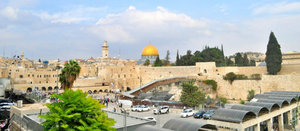Advertisement
Published: February 11th 2013

 The Western Wall
The Western Wall
The Western WallDuring the first few month of my program, we have had several travel/educational days in and around Jerusalem, so this blog will be dedicated to the highlights of those trips.
I have now visited Jerusalem 4 times during my trip. It is the strangest and most historical place I’ve ever been to. Arriving in Jerusalem is a unique experience in itself, as I get off the bus from the relative ‘normality’ of Tel-Aviv; I am surrounded by either orthodox Jews, Israeli soldiers or a few tourists. From the central bus station there’s an awesome light rail that takes you through the city, across the Chords bridge and to Mt. Hertzl, Israel’s national cemetery. Most of the city is hilly makes learning the busses essential.
Mt. Hertzl: Mt. Hertzl is significant in that it was one of the first official places established in Israel following the Israeli War of Independence in 1948. At the top of the Mt. is the tomb for Theodore Herzl, who started the Zionist movement, and who died almost a half century before Israel was established. He died in Vienna but was later reburied in Jerusalem in 1949 per his wishes.
Other significant people who reside there are Jabotinsy, who was the military leader of the Zionist movement in the 1930’s, as well as many of the prime ministers of Israel. Others buried there are Israeli soldiers killed in action, and the only people who can be buried there now are heads of state, or soldiers from Jerusalem. An area of controversy is the tomb of Yitzhak Rabin which is under constant surveillance for vandalism. He was the Prime minister who signed the Oslo peace accords with the Palestinians and was assassinated by an extremist in 1995. It is a sign of the significant division between Jews within Israeli society that have continued since then.
City of David: One of the more interesting historical sites in Israel is the city of David which was built about 3000 years ago. Only areas owned by the State are allowed to be excavated, since most of the city is now under modern day East-Jerusalem. There is a tunnel that runs under the city to transport water and we hiked through it with headlamps, which was a lot of fun. The tunnels were built with pickaxes and were dug from 2
different sides that met in the middle somehow.
Temple Mount: The Temple mount is in the Old City of Jerusalem and is the location of the Golden ‘Dome of the Rock’ building. It is called the Temple mount because in ancient times there was a great temple that stood there, and the top of the mountain was essentially sliced off to make the mount. There is not much to do here except take pictures, most everything is restricted because of the religious significance. Getting into the mount is restricted and non-Muslims can only enter for 1 hour a day around lunchtime. There are some rocks there that are claimed to be the origin of the Earth or something like that. After the hour everyone yells at you to leave.
Christian Quarter One of the biggest crowds in the Old city is from all the pilgrims in the Christian Quarter. There’s a lot of different churches and sites to see here, and a lot of people like to follow the path that Jesus walked before his crusifixation. On that note, I did legitimately see a guy strolling by carrying a giant cross, nbd.

 Sunset In Jerusalem
Sunset In Jerusalem
Sunset In JerusalemBy the end of the day we were exhausted from the walk and all the people and more than happy to go.
There is much more to Jerusalem then these sights, but these are the highlights I remembered and enjoyed most.
Advertisement
Tot: 0.162s; Tpl: 0.019s; cc: 10; qc: 48; dbt: 0.0504s; 1; m:domysql w:travelblog (10.17.0.13); sld: 1;
; mem: 1.1mb

 The Western Wall
The Western Wall
 Sunset In Jerusalem
Sunset In Jerusalem